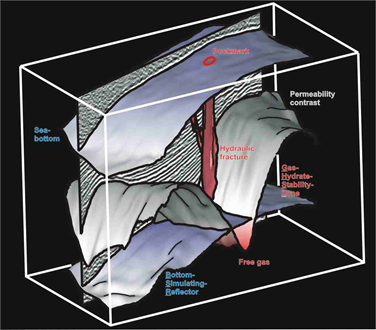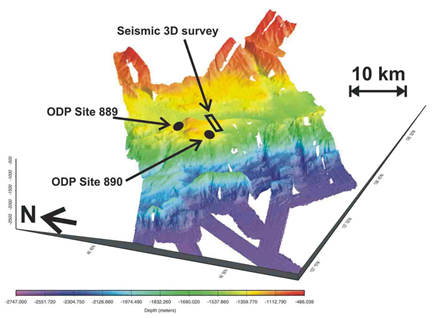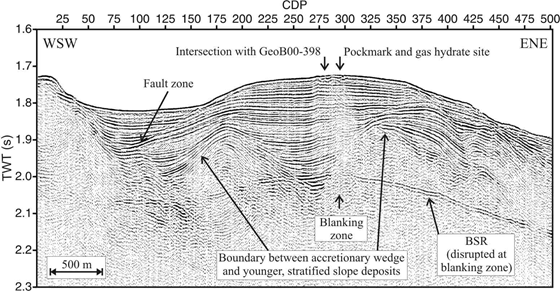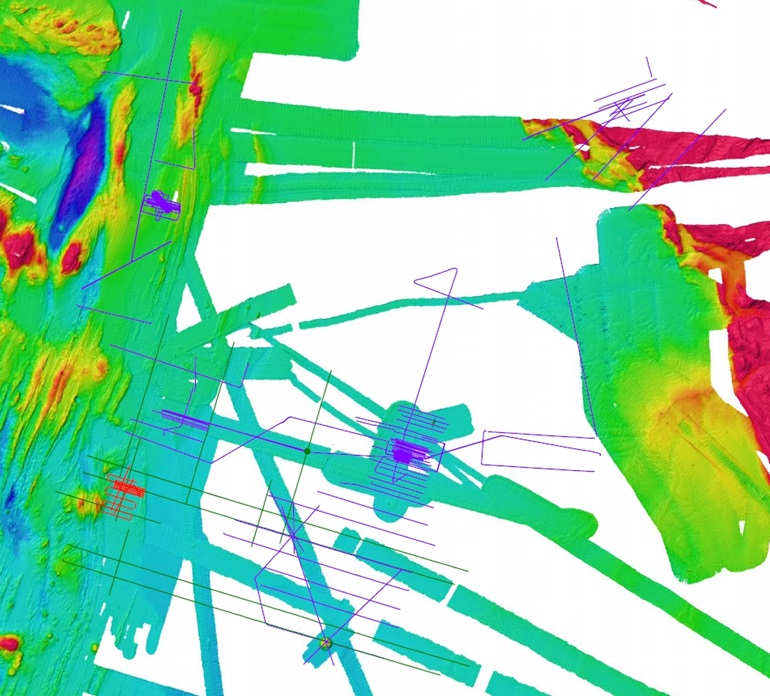Cascadia Basin and Margin
The Cascadia Basin became in 1996 our first focus area of research after the 'Sedimented Ridges' drilling proposals have been submitted to study the effect of (thick) sediment on young oceanic crust. On ODP Leg 168 basically causes and consequences of ridge-flank hydrothermal circulation have been investigrated. Vigorous hydrothermal circulation at ridges extracts large amounts of heat compared to just conductive heat flow. But when sediment covers oceanic crust, this cooling effect is attenuated, and a normal temperature profile can establish. At the same time, the effect of water circulation through the oceanic crust and its associated heat transport was widely unknown. A transect of drill holes away from the ridge confirmed the sediment-basalt interface to represent an isotherm, thus providing a proof for vigorous lateral flow through the oceanic crust. Also, flow within the crust between different outcrops or seamounts, which stick out and connect to seawater, could be confirmed. Designated inflow and outflow zones at those penetrators establish efficient hydrothermal circulation cells.
Two cruises with R/V Sonne, SO 111 and SO149 were carried out in 1996 and 2000, acquiring seismoacoustic and heat flow data.
Geophysical Signatures of Fluid Flow
One of our key studies in the Cascadia Basin was targeting acoustic anomalies over basement ridges, which we potentially interpreted as fluid upflow zones. Finally, Zühlsdorff & Spiess (2006) could show, that these anomalies were caused by a phenomenon called 'forced folding'.
Site Survey
Our seismic work on SO111 and SO149 further extended the spatial understanding on crustal fabrics and timing, distribution and thickness of sediments. Site survey data were collected for the follow-up drilling IODP Exp 301 (Zühlsdorff et al., 2005). In addition, a 3D seismic survey at First Ridge was intended to gain a spatial view on crustal fabrics, faulting, fluid flow and sediment deformation (Zühlsdorff & Spiess, 2006)
Middle Valley
Middle Valley represents zero age crust covered by thick sediments thus creating a special environment for active volcanism. The two ODP drilling Legs 139 and 169 targeted the development of sulphidic ores within the sediment column.
CO2 Storage in Oceanic Crust
In 2018, we participated in a funding proposal "CARbon dioxide Offshore storage and Mineralization in BAsalt (CAROMBA)" by scientists from Canada, US, Norway, France, UK, Iceland submitted to the ACT program (Accelerating CCS Technologies) as part of the EU ERA-Net funding scheme.
While the proposal failed, in 2021 a group of US, Canadian, and German scientists submitted an RFI (Request for Information) to the new phase of international drilling, proposing a CO2 injection experiment at sites, which had been previous used to investigate hydrology.
Our contribution will be a refined seismic study of the oceanic crust down to seismic resolution of few meters to predict connectivity and pathways for flow.
Cascadia Margin - Gas Hydrates and Fluid Flow
For a test survey of the seismic setup on SO111, an area around a presumed pockmark had been suggested by our Canadian colleague E.E. Davis, which led to the publication of Zühlsdorff et al. (2000) about the relationship of depth and strenght of the BSR reflection and the position of and uprising fluids at the pockmark.
The distinct elongated pockmark orientation perpendicular to the main stress field, created by the compressional forces acting at this accretionary margin, lead to the conclusion that not deformation, but natural hydraulic fracturing has initiated and maintained the pockmark, which is fundamentally different from the mostly favored assumption of overpressured gas accumulations (Zühlsdorff & Spiess, 2004)

Fluid flow model at Bullseye Vent based on a 3D single streamer seismic data set acquired on SO149 (Zühlsdorff & Spiess, 2004) confirming natural hydraulic fracturing as main possible cause for pockmark formation.
Cruises
- R/V Sonne Cruise SO111
- R/V Sonne Cruise SO149
- ODP Leg 139 - Middle Valley
- ODP Leg 146 - Cascadia Margin Gas Hydrates
- ODP Leg 168 - Crustal Hydrogeology
- ODP Leg 169 - Middle Valley
- IODP Exp 301 - Crustal Hydrogeology
- IODP Exp 311 - Cascadia Margin Gas Hydrates
- IODP Exp 327 - Crustal Hydrogeology
- IODP Exp 327S - Cascadia Margin Fluid Flow
- IODP Exp 328 - Cascadia Margin ACORK
Funding Projects
1996-1997 BMBF ADVEKTSEIS (SO111)
1998-1999 DFG Fluidmigration im Cascadia Becken - Vergleich hochauflösender Seismik mit sedimentphysikalischen Daten von ODP Leg 168
2000-2002 BMBF IMAGEFLUX (SO149)
2004-2006 DFG Cascadia Basin basement tectonics, temporal and spatial development of the sediment cover, and evolution of the hydrothermal flow system
Publications
Cascadia Basin
Zühlsdorff, L., and V. Spiess (2006), Sedimentation patterns, folding, and fluid upflow above a buried basement ridge: Results from 2-D and 3-D seismic surveys at the eastern Juan de Fuca Ridge flank, J. Geophys. Res., 111, B08103, doi:10.1029/2004JB003227.
Hutnak, M., A. T. Fisher, L. Zühlsdorff, V. Spiess, P. H. Stauffer, and C. W. Gable (2006), Hydrothermal recharge and discharge guided by basement outcrops on 0.7–3.6 Ma seafloor east of the Juan de Fuca Ridge: Observations and numerical models, Geochem. Geophys. Geosyst., 7, Q07O02, doi:10.1029/2006GC001242.
Zühlsdorff, L., M. Hutnak, A. T. Fisher, V. Spiess, E. E. Davis, M. Nedimovic, S. Carbotte, H. Villinger & K. Becker (2005) Site surveys prior to IODP Expedition 301: ImageFlux (SO 149) and RetroFlux (TN116) expeditions and earlier studies. IODP Leg 301 Initial Reports. doi:10.2204/iodp.proc.301.102.2005.
GA Spinelli, L Zühlsdorff, AT Fisher, CG Wheat, M Mottl, V Spiess, ... (2004) Hydrothermal seepage patterns above a buried basement ridge, eastern flank of the Juan de Fuca Ridge (DOI 10.1029/2003JB002476). Journal of Geophysical Research-Part B-Solid Earth 109 (1)
Fisher, A. T., E. E. Davis, M. Hutnak, V. Spiess, L. Zühlsdorff, A. Cherkaoui, L. Christiansen, K. Edwards, R. MacDonald, H. Villinger, M. J. Mottl, C. G. Wheat & K. Becker (2003) Hydrothermal recharge and discharge across 50 km guided by seamounts on a young ridge flank, Nature, 421, 618-621.
Zühlsdorff, L., Spiess V. (2001) Modeling seismic reflection patterns from Ocean Drilling Program Leg 168 core density logs: Insight into lateral variations in physical properties and sediment input at the eastern flank of the Juan de Fuca Ridge. J. Geophys. Res., 106, 16119-16133.
Zühlsdorff, L., V. Spiess, C. Hübscher, and M. Breitzke (1999) Seismic reflectivity anomalies in sediments at the eastern flank of the Juan de Fuca Ridge - evidence for fluid migration. J. Geophys. Res., 104, 15351-15364.
Cascadia Margin
Zühlsdorff L and V. Spiess (2004) Three-dimensional seismic characterization of a venting sites reveals compelling indications of natural hydraulic fracturing, Geology, 32: 101-104.
Zühlsdorff, L., V. Spiess, C. Hübscher, H. Villinger, and A. Rosenberger (2000) Implications for focused fluid transport at the northern Cascadia accretionary prism from a correlation between BSR occurrence and near-sea-floor reflectivity anomalies imaged in a multi-frequency seismic data set, Int. J. Earth Sci., 88, 655-667.

Bathymetry around Bullseye Vent acquired on SO111 and SO149 cruises.
 SO149 seismic Line GeoB00-1xx across Bullseye Vent (Zühlsforff et al., 2000)
SO149 seismic Line GeoB00-1xx across Bullseye Vent (Zühlsforff et al., 2000)
Theses
PhD
Zühlsdorff, Lars - 1996-1999 - High Resolution Multi-Frequency Seismic Surveys at the Eastern Juan de Fuca Ridge Flank and the Cascadia Margin - Evidence for Thermally and Tectonically Driven Fluid Upflow in Marine Sediments
Master
Albers Aike - 2023 - Seismic Exploration and Characterization of the basaltic CCS Reservoir on the Eastern Juan de Fuca Ridge Flank
Koletzek, Arnold - 2016 - Die dreidimensionale Abbildung einer Überdruckzone im Bullseye Vent am Cascadia Kontinentalrand
Schalkwijk, Sven - 2016 - Sedimentary Evolution of the Northern Cascadia Accretionary Margin, offshore Vancouver Island, Canada - Reprocessing of Multichannel Seismic Data from 2000, Sonne Cruise SO 149
Ayokunnumi, Ojo - 2016 - Statistical estimation of crustal roughness of the Endeavour segment of the Juan de Fuca Plate from multichannel seismic data


